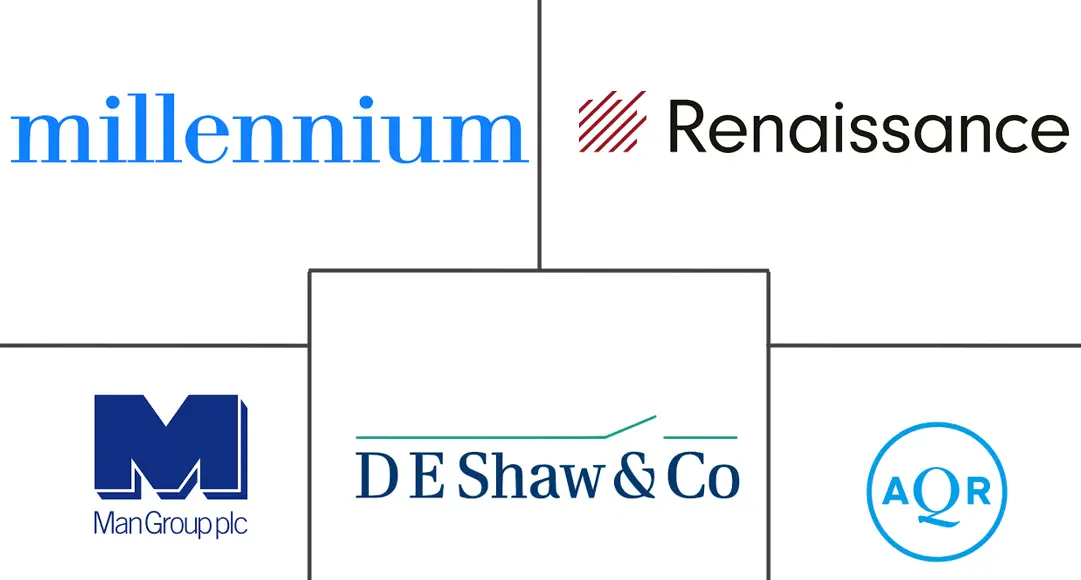Hedge Fund Market Size and Share
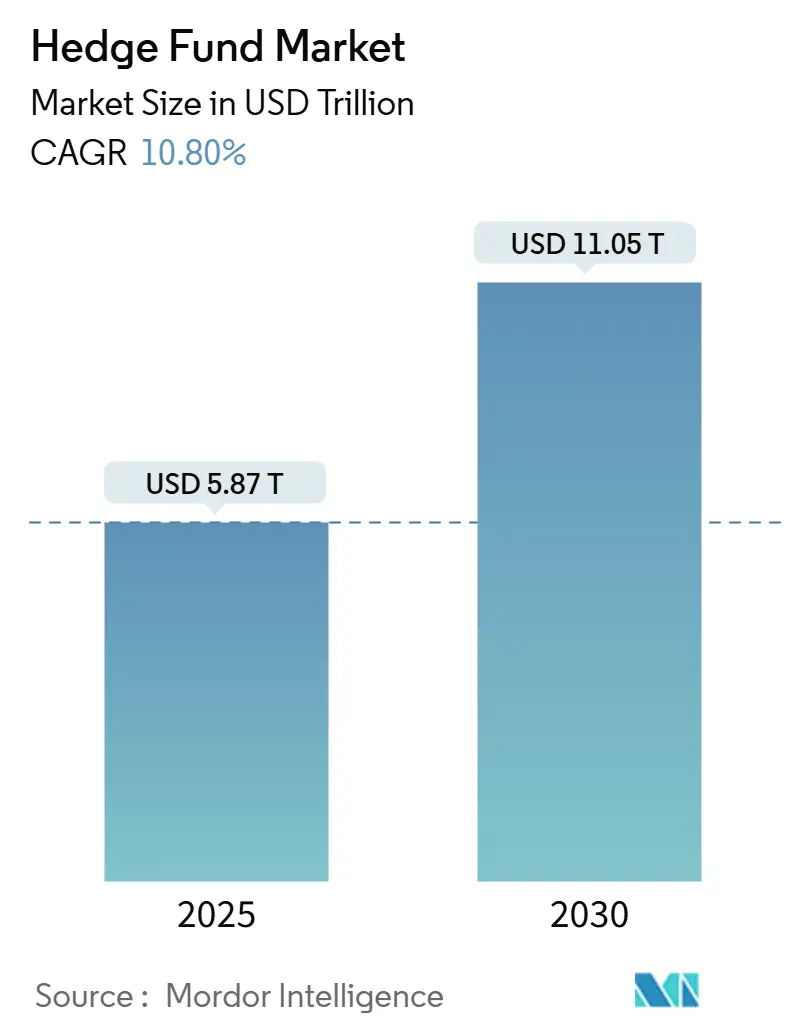
Hedge Fund Market Analysis by Mordor Intelligence
The Hedge Fund Market size is estimated at USD 5.87 trillion in 2025, and is expected to reach USD 11.05 trillion by 2030, at a CAGR of 10.80% during the forecast period (2025-2030).
This expansion is propelled by institutional reallocations away from stressed 60/40 portfolios, an elevated interest-rate environment that boosts cash-collateral yields, and rapid deployment of artificial intelligence across research and trading desks. Asia-Pacific registers the quickest asset growth as regulatory liberalization in China and a USD 5.8 trillion intergenerational wealth transfer reshape regional capital flows. Multi-strategy platforms gain share because they industrialize talent acquisition, risk controls, and data infrastructure, while fee transparency demands and prime-broker margin tightening pressure smaller managers. Tokenization and digital distribution channels widen access to alternatives, positioning blockchain-based fund wrappers as a meaningful contributor to new asset inflows by the end of the decade.
Key Report Takeaways
- By strategy, long/short equity led with 32.3% of the hedge fund market share in 2024, whereas multi-strategy funds are projected to expand at a 12.34% CAGR through 2030.
- By investor type, institutional investors held 73.4% of the global hedge fund market share in 2024; family offices are expected to advance at an 8.43% CAGR by 2030.
- By fund structure, onshore vehicles commanded 55.4% of the hedge fund market size in 2024, while offshore funds are forecast to grow at a 9.54% CAGR over the same period.
- By distribution channel, fund of funds retained 34.5% of the hedge fund market share in 2024, yet wealth and private platforms show the fastest trajectory at an 8.61% CAGR.
- By geography, North America accounted for 70.2% of the hedge fund market size in 2024, whereas Asia-Pacific maintains the highest regional CAGR at 13.23% through 2030.
Global Hedge Fund Market Trends and Insights
Drivers Impact Analysis
| Driver | (~) % Impact on CAGR Forecast | Geographic Relevance | Impact Timeline |
|---|---|---|---|
| Institutional reallocation amid 60/40 strain | +2.8% | North America & EU | Medium term (2-4 years) |
| Rise of alternative data & quant strategies | +1.9% | North America and Asia-Pacific | Long term (≥ 4 years) |
| High interest-rate carry on cash collateral | +1.5% | Global | Short term (≤ 2 years) |
| Loosening of China’s QDLP/QFLP schemes | +1.2% | Asia-Pacific core | Medium term (2-4 years) |
| Tokenization & digital-asset funds | +0.8% | Early adoption in North America & EU | Long term (≥ 4 years) |
| Expansion of multi-strategy platforms | +2.1% | North America | Medium term (2-4 years) |
| Source: Mordor Intelligence | |||
Institutional Reallocation Amid 60/40 Portfolio Strain
Central bank normalization and geopolitical pressures have reduced the effectiveness of traditional balanced portfolios[1]Federal Reserve Board, “Monetary Policy Report,” federalreserve.gov. Public pensions lifted alternative allocations from 9% in 2001 to nearly 30% in 2022, and hedge funds already represent 6% of total pension assets. Endowments now place more than 75% in alternatives, while sovereign wealth funds view hedge funds as essential volatility dampeners. Consultants cite enhanced alpha potential, not greater risk tolerance, as the motivation. Dispersion across equities and rates widens, giving active managers more room to harvest idiosyncratic return streams. The hedge fund market, therefore, benefits from structurally higher baseline allocations.
Rise of Alternative Data & Quant Strategies
Satellite imagery, transactional exhaust, and social-media sentiment datasets are reshaping security selection[2]NASA Harvest, “Remote-Sensing Data for Finance,” nasa.gov. Machine-learning models process petabytes of unstructured content, extracting signals unavailable to fundamental teams a decade ago. BlackRock’s “Asimov” virtual analyst ingests filings in multiple languages and drafts investment briefs in seconds. Chinese quant managers expanding under relaxed outbound quotas intensify global demand for alternative data. Generative AI allows strategy developers to prototype trading rules by querying natural language rather than writing code. Data-centric processes, therefore, improve scalability and reinforce the competitive moat of well-capitalized platforms within the hedge fund market.
High Interest-Rate Carry on Cash Collateral
With policy rates hovering at multidecade highs, short rebate income has experienced a notable surge. Funds are now reaping returns exceeding 5% on their cash balances, marking the most significant advantage since 2007[3]Justina Lee and Lu Wang, “Short Rebate Windfall Lifts Hedge-Fund Returns,” bloomberg.com. This environment has created a favorable backdrop for hedge funds, particularly for strategies that are net-short, which are witnessing the most pronounced uplift. The daily compounding of cash collateral significantly enhances gross returns, even before factoring in alpha. The Treasury cash-futures basis trade, with a notional exposure nearing USD 1 trillion, underscores the scale and importance of these carry opportunities in the current market landscape.
Loosening of China’s QDLP/QFLP Schemes
Beijing is easing both inbound and outbound allocation quotas, giving global managers wider access to China's domestic capital and enabling Chinese investors to diversify their portfolios overseas. By early 2024, over 800 institutions had secured Qualified Foreign Institutional Investor licenses, amassing allocations that surpassed RMB 105.12 billion. This relaxation of quotas is expected to further enhance cross-border investment flows and foster greater integration between domestic and international markets. Programs like Bond Connect are broadening hedging avenues for global funds, offering more flexibility and efficiency in managing risks. With the renminbi's ongoing liberalization, there's a surge in launches across Asia, solidifying the region's prominence in hedge-fund asset accumulation and positioning it as a key player in the global financial ecosystem.
Restraints Impact Analysis
| Restraint | (~) % Impact on CAGR Forecast | Geographic Relevance | Impact Timeline |
|---|---|---|---|
| Fee compression & expense transparency | −1.8% | North America & EU | Medium term (2-4 years) |
| Prime-broker margin tightening | −1.2% | Global | Short term (≤ 2 years) |
| ESG Compliance Under EU SFDR | -0.9% | Europe primary, spillover to global managers | Medium term (2-4 years) |
| Quant Talent Cost Inflation | -0.7% | Global, concentrated in North America & Asia-Pacific | Long term (≥ 4 years) |
| Source: Mordor Intelligence | |||
Fee Compression & Expense Transparency Demands
As performance falls short of benchmarks, investors are increasingly resistant to the traditional 2-and-20 fee structure. A recent survey by BNP Paribas highlights a notable shift: average performance fees are set to rise to 17.8% in 2024, marking the first increase in a decade. In a move to safeguard returns, pension systems like Texas TRS have introduced cash hurdles, allowing managers to charge fees only when returns surpass T-bill yields. Furthermore, there's heightened scrutiny on passthrough costs, data, travel, and compliance. Its intensified oversight has led to more frequent side-letter negotiations and clawbacks. While top-tier franchises manage to uphold their pricing due to consistent alpha generation, mid-tier managers face redemption risks unless they adjust their fee structures.
Prime-Broker Margin Tightening
In 2023, prime-broker revenues hit a record USD 32 billion. However, this success is shadowed by concerns of systemic risk due to concentration among the top five brokers, which dominate the market. Stricter margin terms, linked to reduced hedge-fund alpha, have emerged as a response to Basel III capital rules and lessons from the Archegos collapse. These rules have prompted dealers to cut leverage and widen financing haircuts, further tightening the operational environment for hedge funds. While smaller funds grapple with heightened minimum-revenue hurdles, often falling short, they find themselves turning to pricier challenger primes that offer limited cost advantages. Consequently, the hedge fund market increasingly favors larger players, those equipped to navigate and absorb escalating collateral demands, thereby consolidating market power among scale players.
Segment Analysis
By Strategy: Multi-Strategy Platforms Drive Consolidation
The hedge fund market size for strategy mandates reached its height, with Long/Short Equity retaining a 32.3% slice of the hedge fund market share in 2024. Multi-strategy mandates post the fastest 12.34% CAGR, reflecting allocator demand for diversified, risk-budget-controlled exposure under one umbrella. Multi-strategy talent pods can pivot capital rapidly, exploiting volatility clusters across rates, commodities, and equities, while shared infrastructure reduces unit costs. Event-driven funds leverage elevated M&A spreads as jumbo break fees cushion the downside. Global Macro desks benefit from diverging central bank paths, and Relative-Value specialists mine dislocations created by quantitative tightening.
Competitive intensity inside the hedge fund market mounts as mega-platforms dominate recruiting pipelines. Citadel and Millennium integrate AI-driven risk scoring that evaluates pod convexity under 10,000 stress scenarios per hour. Quant/Systematic strategies focus on alternative data ingestion pipelines that compress signal decay. Fund-of-funds allocations taper because sophisticated allocators can build multi-manager sleeves internally, yet boutique FoF providers persist by bundling capacity with niche specialists. Technology, not just insight, increasingly defines enduring edges across strategies.
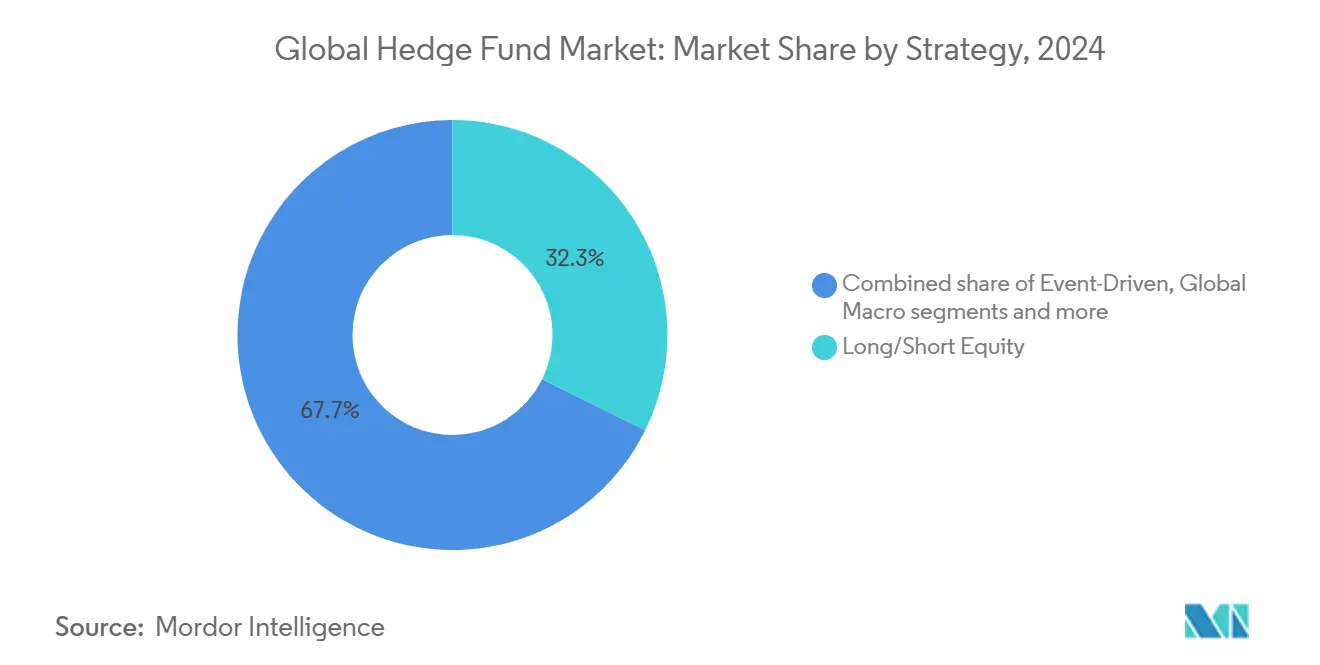
Note: Segment shares of all individual segments available upon report purchase
By Investor Type: Institutional Dominance Amid Family-Office Growth
Institutional investors owned 73.4% of the hedge fund market size across end-2024 assets, underscoring their entrenched influence on mandate terms. Pension plans value downside protection and liquidity, while insurers employ hedges against credit-spread widening. Family-office allocations compound at 8.43% CAGR as Asia-Pacific wealth passes to next-generation principals seeking yield diversification. The hedge fund market benefits from the region’s family-office count quadrupling since 2020.
Family-office sophistication rises: 60% now employ CIOs, and many build proprietary risk dashboards that benchmark hedge-fund exposures against private-market bets. Tokenized feeder funds lower administrative hurdles, letting ultra-high-net-worth clients commit capital in USD 10,000 equivalents rather than traditional USD 1 million tickets. Institutional hesitancy over fee structures persists at 35%, indicating lower net-new allocations in 2025, yet core relationships with top-decile performers remain sticky, anchoring capital flows within the global hedge fund market.
By Fund Structure: Offshore Momentum Accelerates
In 2024, onshore domiciles like Delaware and Luxembourg commanded 55.4% of the hedge fund market share, benefiting from their regulatory familiarity and robust investor protections. Institutional investors have long preferred these jurisdictions due to their well-established legal frameworks and investor-friendly policies. Meanwhile, offshore jurisdictions, led by the Cayman Islands and British Virgin Islands, are witnessing a 9.54% CAGR growth. This surge is attributed to modernized AML screening processes and the introduction of digital filing portals, which enhance operational efficiency and compliance. Singapore, eyeing the future, has extended tax incentives under Sections 13O and 13U until 2029, with conditions on minimum AUM thresholds to promote scaling. These measures aim to attract fund managers and position Singapore as a leading hub for pan-regional vehicles, further strengthening Asia's role in the hedge fund market.
As OECD transparency frameworks tighten, they inadvertently inflate costs, nudging managers towards advanced reporting technologies to meet compliance requirements. While UCITS wrappers hold allure for distribution across EMEA's retail networks due to their standardized structure and investor protections, their leverage caps pose limitations on specific strategies, particularly those requiring higher risk exposure. Within the hedge fund landscape, the choice of structure is a delicate dance, weighing global tax efficiency against marketing reach and operational intricacies. Consequently, managers are increasingly turning to multiple fund shells, tailoring their approach to meet the diverse profiles of limited partners (LPs). This strategy allows them to address varying regulatory, tax, and investment preferences across different regions effectively.
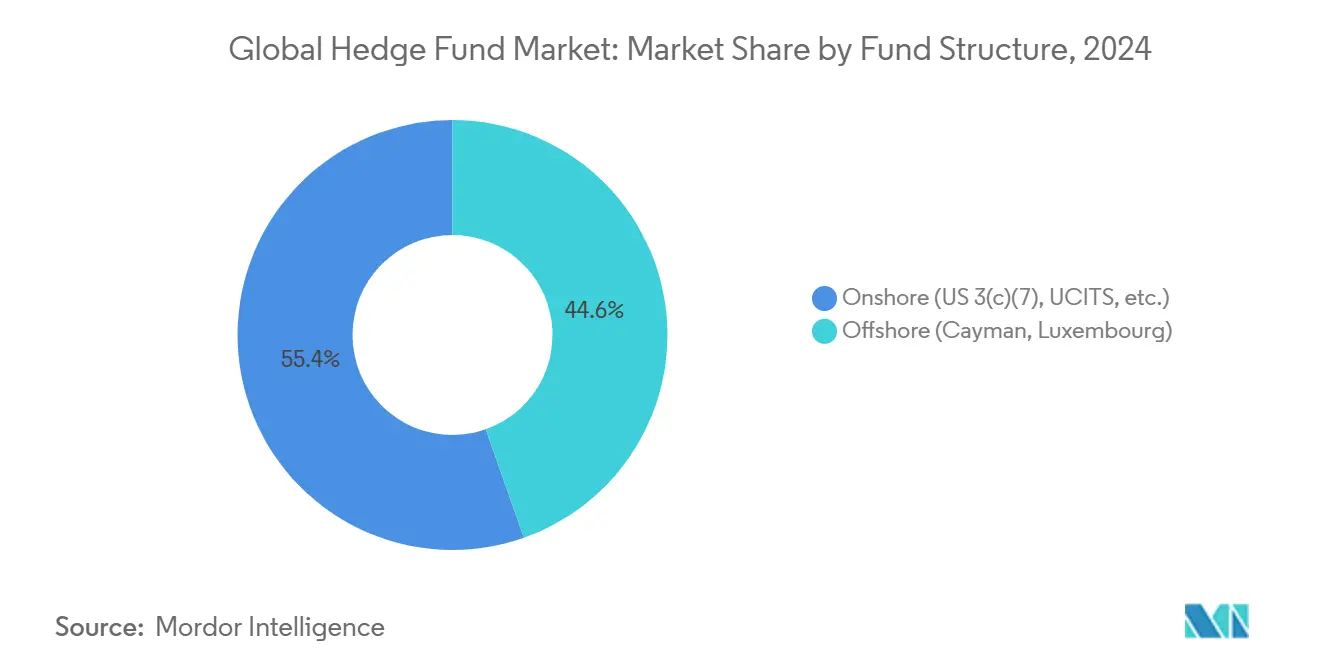
Note: Segment shares of all individual segments available upon report purchase
By Distribution Channel: Wealth Platforms Gain Momentum
In 2024, Fund-of-Funds account for 34.5% of asset flows, yet their share of new investments is waning as institutional LPs shift towards direct engagements. This trend reflects a growing preference among institutional investors for greater control and cost efficiency in their allocations. Wealth and private-bank platforms, leveraging APIs for smoother digital subscriptions and KYC verifications, are witnessing an 8.61% CAGR in asset growth. These platforms are increasingly integrating advanced technologies to enhance user experience and operational efficiency. Wellington's collaboration with iCapital showcases the role of technology in expediting allocation times for financial-adviser networks, enabling quicker access to investment opportunities. Consequently, the hedge fund market is broadening its appeal to a wider mass-affluent audience, all while maintaining institutional customization for its flagship share classes to meet the specific needs of high-value clients.
Tokenized feeder structures are now listed on secondary trading systems, allowing for intra-day liquidity without necessitating a turnover of the underlying portfolio. This innovation provides investors with greater flexibility and access to liquidity while preserving the integrity of the core investment strategy. For mega-allocators, direct institutional mandates are crucial, offering tailored risk profiles and customized transparency dashboards that align with their specific investment objectives. With rising expectations for data sharing, distribution channels are setting themselves apart based on the depth of real-time position analytics they provide to end buyers. These analytics enhance decision-making and foster trust and transparency between asset managers and investors.
Geography Analysis
North America dominated the hedge fund market size at 70.2% in 2024, reflecting the concentration of sophisticated LP capital, mature prime-broker networks, and deep secondary financing pools. US managers benefit from liquid derivative markets that support complex basis trades, while Canadian pensions supply steady seed tickets for niche strategies. Yet growth decelerates because some state systems rebalance toward private credit and infrastructure to match liability profiles, and because regulatory capital rules raise the hurdle rate for leverage.
Europe accounts for a moderate portion of global assets, with Germany and the Netherlands re-engaging after prior retrenchment. EU Sustainable Finance Disclosure Regulation requirements increase compliance workloads, encouraging smaller firms to outsource middle-office tasks or relocate to light-touch regimes such as Ireland’s QIAIF framework. Luxembourg’s RAIF structure gains traction among US managers targeting pan-European distribution. Consequently, European asset inflows hinge on managers’ capacity to evidence ESG integration without diluting investment flexibility.
Asia-Pacific registers the fastest 13.23% CAGR, underpinned by China’s QDLP/QFLP relaxations and the region’s large upcoming wealth transfer. Hong Kong’s talent pool rebounds as mobility restrictions ease, drawing multi-strategy franchises such as Millennium and Sona. Singapore extends tax incentives, and Australia’s superannuation funds increase hedge-fund sleeves to offset equity-market concentration risk. Japanese allocators leverage local equity dispersion and currency volatility to justify new mandates. As Asia’s capital markets deepen, regional dispersion of trading venues and regulatory differences create distinctive alpha sources, solidifying Asia-Pacific’s role in shaping the future hedge fund market.
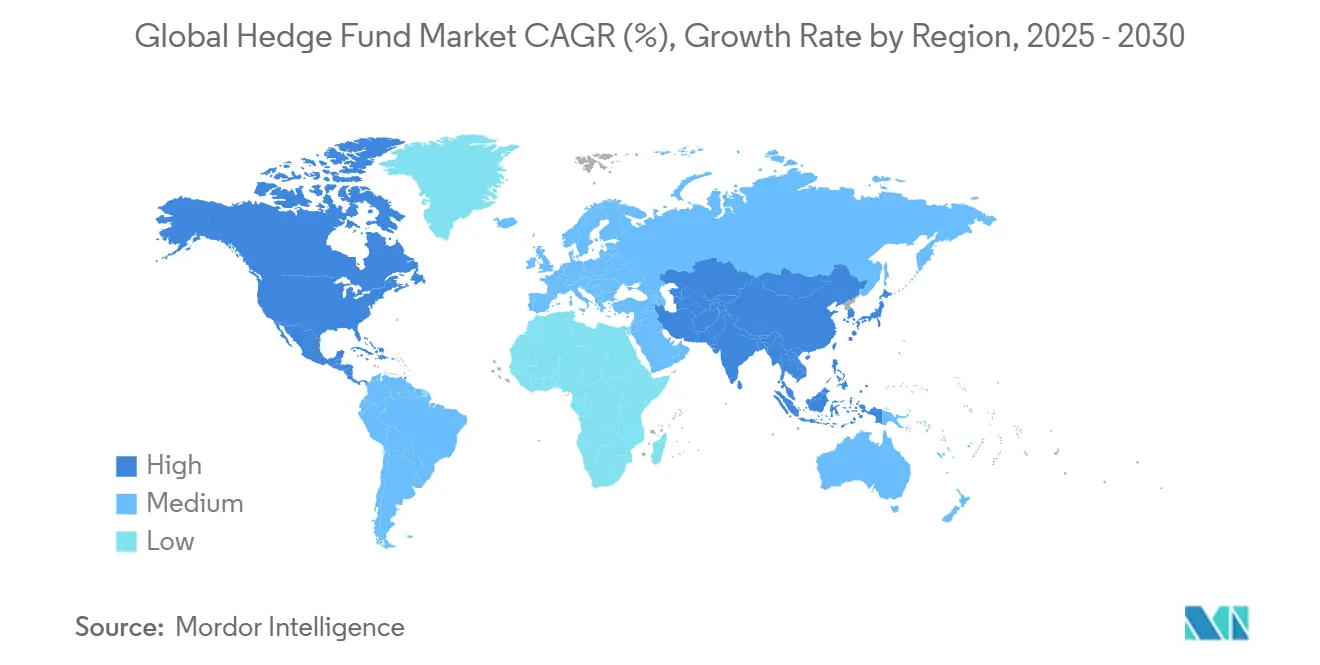
Competitive Landscape
Mega platforms tighten their grip on the hedge fund market as the top five players employ the majority of platform personnel, indicating high market concentration. Their operating models resemble internal marketplaces that auction capital to pods scoring high on risk-adjusted return forecasts. Citadel’s centralized technology stack executes more than 60 million trades daily across asset classes, while Millennium deploys AI monitors that pulse liquidity metrics to every team in real-time. Point72 commits dedicated R&D spending to natural-language-processing pipelines that parse regulatory commentary minutes after release.
Scale advantages cascade into lower financing spreads negotiated with prime brokers. Goldman Sachs and Morgan Stanley extend balance-sheet capacity preferentially to high-volume clients, widening the cost gap versus mid-size funds. Data-vendor contracts increasingly feature enterprise-wide licensing unavailable to smaller peers. Consequently, sub-USD 1 billion managers face an uphill path unless they target capacity-constrained, specialist strategies such as catastrophe reinsurance or frontier-market credit.
Technology investment underpins strategic differentiation. BlackRock integrates its Aladdin analytics into hedge-fund pods, merging public and private-market datasets. Meanwhile, Man Group collaborates with cloud providers to reduce model-training runtimes by 70%. Tokenization partnerships emerge: Partners Group links with BlackRock to embed private-market sleeves into model portfolios distributed through wealth channels. These moves demonstrate that the competitive frontier now spans both portfolio construction and digital product design within the hedge fund market.
Hedge Fund Industry Leaders
-
Man Group plc
-
Renaissance Technologies LLC
-
Millennium Management LLC
-
AQR Capital Management
-
D.E. Shaw & Co.
- *Disclaimer: Major Players sorted in no particular order
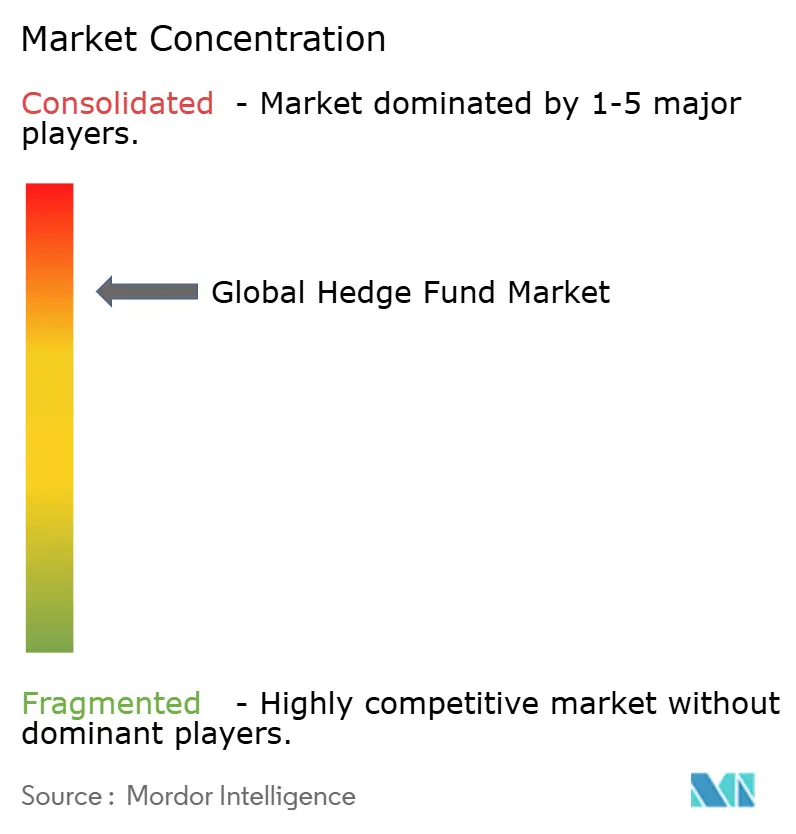
Recent Industry Developments
- June 2025: Millennium Management opened talks to sell a minority stake that values the firm at USD 14 billion, signaling external interest in platform economics.
- May 2025: First Eagle Investments accepted a strategic majority investment from Genstar Capital, aiming to expand solution breadth while preserving its investment-led culture.
- April 2025: Wellington Management, Vanguard, and Blackstone to package public and private assets into multi-asset solutions accessible to a wider investor base.
- March 2025: Polymer Capital launched two Japan-focused hedge funds, reflecting rising demand for regional specialization in Asia.
Research Methodology Framework and Report Scope
Market Definitions and Key Coverage
Our study treats the hedge fund industry as the aggregate assets under management held by professionally managed pooled vehicles that actively employ leverage, short-selling, and derivative overlays across liquid markets to harvest absolute returns. The figure includes onshore and offshore funds operating under limited-partner or UCITS-type wrappers and reporting monthly or quarterly net asset values.
Scope exclusion: proprietary trading desks, private equity, venture capital, and closed-ended listed funds fall outside this boundary.
Segmentation Overview
- By Strategy
- Long/Short Equity
- Event-Driven
- Global Macro
- Relative Value
- Multi-Strategy
- Quantitative / Systematic
- Fund of Funds
- By Investor Type
- Institutional Investors (Pension Funds, SWFs, Insurers)
- High-Net-Worth & Family Offices
- Retail (Qualified)
- By Fund Structure
- Onshore (US 3(c)(7), UCITS, etc.)
- Offshore (Cayman, Luxembourg)
- By Distribution Channel
- Direct Institutional Mandates
- Fund of Funds
- Wealth / Private-Bank Platforms
- Digital Marketplaces & Tokenized Funds
- By Geography
- North America
- Canada
- United States
- Mexico
- South America
- Brazil
- Argentina
- Rest of South America
- Asia-Pacific
- India
- China
- Japan
- Australia
- South Korea
- South East Asia (Singapore, Malaysia, Thailand, Indonesia, Vietnam, and Philippines)
- Rest of Asia Pacific
- Europe
- United Kingdom
- Germany
- France
- Spain
- Italy
- BENELUX (Belgium, Netherlands, and Luxembourg)
- NORDICS (Denmark, Finland, Iceland, Norway, and Sweden)
- Rest of Europe
- Middle East And Africa
- United Arab of Emirates
- Saudi Arabia
- South Africa
- Nigeria
- Rest of Middle East And Africa
- North America
Detailed Research Methodology and Data Validation
Primary Research
Mordor analysts held structured calls with allocators across North America, Europe, and Asia-Pacific, alongside prime brokers, auditors, and independent directors to validate asset flow assumptions, fee glide paths, and leverage norms, filling gaps uncovered in desk research.
Desk Research
We began with global asset flow releases from entities such as the IMF's Coordinated Portfolio Investment Survey, the BIS locational banking statistics, and IOSCO hedge fund surveys, which anchor cross-border exposure. Annual reports and Form PF abstracts, supplemented by SEC ADV filings, granted granular strategy splits. Trade bodies, such as AIMA and the Managed Funds Association, provided fee trends and regulatory updates, while press coverage in Dow Jones Factiva kept us current on fund launches and liquidations. Select paid feeds, notably D&B Hoovers for manager financials and Questel for strategy-linked patent activity, enriched our universe list. This list is illustrative, not exhaustive, of sources tapped during secondary work.
Market-Sizing & Forecasting
A top-down build starts with reported global hedge fund AUM, reconciling IMF and HFR prints, which are then adjusted for unreported small managers using region-specific prevalence factors. Supplier roll-ups of audited statements act as a bottom-up reasonableness check before totals are locked. Key model inputs include quarterly net capital inflows, blended management and performance fee progression, prime brokerage gross leverage ratios, exchange-traded volatility indices, and regional wealth pool growth. Multivariate regression captures how these drivers influence asset growth, and scenario analysis tests sensitivity to macro stress. Data gaps in manager rolls are bridged by applying median leverage and fee metrics from peer cohorts matched on strategy and domicile.
Data Validation & Update Cycle
Outputs pass a two-tier analyst review that flags variances exceeding historic one-sigma bands. Where anomalies persist, sources are re-contacted. Our models refresh each year, with interim updates triggered by material events such as regulatory shifts or liquidity shocks.
Why Mordor's Hedge Fund Industry Size & Share Analysis Baseline Proves Reliable
Published hedge fund totals rarely match because firms diverge on fund types counted, treatment of side pockets, currency translation dates, and refresh cadence.
Key gap drivers include narrower strategy coverage, older base years, single-source dependence, or flat fee assumptions that understate compounding. Mordor's inclusion of tokenized feeders, quarterly FX recalibration, and yearly primary confirmations reduces these blind spots.
Benchmark comparison
| Market Size | Anonymized source | Primary gap driver |
|---|---|---|
| USD 5.87 trn (2025) | Mordor Intelligence | - |
| USD 5.30 trn (2024) | Global Consultancy A | Excludes digital asset and multi-strategy hybrids; applies fixed 2/20 fee set |
| USD 4.88 trn (2024) | Industry Association B | Uses single currency conversion at prior year average; omits start-up funds under USD 100 mn |
| USD 4.80 trn (2022) | Trade Journal C | Older base year and no quarterly asset inflow adjustments |
Taken together, the comparison shows that once scope breadth, fee drift, and currency timing are equalized, Mordor's numbers offer the most up-to-date, transparent baseline that decision-makers can trace back to verifiable variables and clearly repeatable steps.
Key Questions Answered in the Report
What is the projected size of the hedge fund market by 2030?
The global hedge fund market is expected to reach USD 11.05 trillion by 2030, expanding at a 10.8% CAGR.
Which strategy segment is growing fastest?
Multi-strategy funds post the quickest growth at a 12.34% CAGR, driven by institutional demand for diversified, risk-controlled returns.
Why is Asia-Pacific attracting more hedge-fund assets?
Regulatory liberalization, such as China’s QDLP/QFLP reforms and a USD 5.8 trillion wealth transfer, are propelling a 13.23% CAGR in the region.
How are higher interest rates affecting hedge funds?
Elevated policy rates lift cash-collateral yields above 5%, providing a direct boost to short-selling and basis-trade strategies.
What role does tokenization play in hedge-fund growth?
Tokenized fund wrappers enhance liquidity and fractional access; industry forecasts suggest these vehicles could command 1% of global AUM—over USD 600 billion—by 2030.
How are fees evolving in the hedge fund industry?
Performance fees averaged 17.8% in 2024, yet investors press for transparency and cash hurdles, prompting mid-size managers to reconsider pricing models.
Page last updated on:
